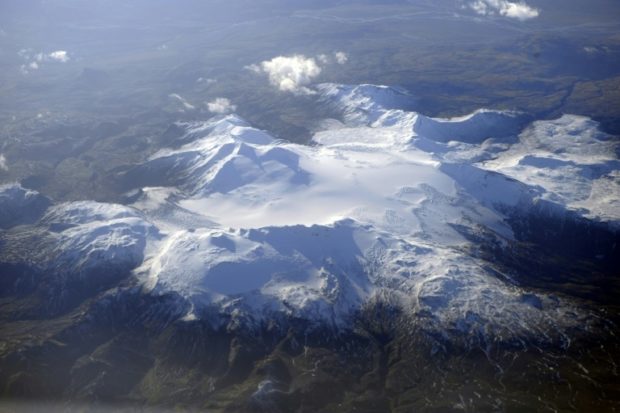Iceland turns carbon dioxide to rock for cleaner air

An aerial view shows a glacier in Iceland. Image: AFP/ Olivier Morin
In the heart of Iceland’s volcano country, 21st-century alchemists are transforming carbon dioxide into rocks for eternity, cleaning the air of harmful emissions that cause global warming.
The technology mimics, in an accelerated format, a natural process that can take thousands of years, injecting carbon dioxide into porous basalt rock where it mineralizes, capturing it forever.
“With this [method,] we have actually changed the time scale dramatically,” said geologist Sandra Osk Snaebjornsdottir.
Carbon dioxide is a greenhouse gas emitted in large quantities by Iceland’s transport sector, industries and volcanoes.
The United Nations (UN) Intergovernmental Panel on Climate Change is promoting various carbon capture and storage (CCS) methods in a bid to limit the rise in average temperatures to 1.5 degrees Celsius.
Snaebjornsdottir is working on Iceland’s CarbFix project with researchers and engineers from utility company Reykjavik Energy, the University of Iceland, France’s National Centre for Scientific Research (CNRS) and Columbia University in the United States.
Petrified in two years
In Iceland, a country of geysers, glaciers and volcanoes, at least half of the energy produced comes from geothermal sources.
That is a bonanza for CarbFix researchers, who have turned the Hellisheidi geothermal power plant, one of the world’s biggest, into their own laboratory.
The plant, located on the Hengill volcano in southwestern Iceland, sits on a layer of basalt rock formed from cooled lava, and has access to virtually unlimited amounts of water.
The plant pumps up the water underneath the volcano to run six turbines providing electricity and heat to the capital, Reykjavik, about 30 kilometers away.
The carbon dioxide from the plant is meanwhile captured from the steam, liquified into condensate, then dissolved in large amounts of water.
“So basically we are just making soda water out of the [carbon dioxide],” said project director Edda Sif Aradottir.
The fizzy water is piped several kilometers to an area where grey, igloo-shaped domes dot a lunar-like landscape. Here the fizzy water is injected under high pressure into the rock 1,000 meters under the ground.
The solution fills the rock’s cavities and begins the solidification process — a chemical reaction that occurs when the gas comes in contact with the calcium, magnesium and iron in the basalt.
“Almost all of the injected [carbon dioxide] was [mineralized] within two years in our pilot injection,” Snaebjornsdottir said.
Once the [carbon dioxide] is turned to rock, it is pretty much captured there for good.
“If you have a volcanic eruption… and you heat up the rock to very high temperatures, then some of the mineral will break down and maybe dissolve in water,” said University of Iceland geochemist Sigurdur Gislason.
But, he noted, “this is the safest and most stable form of storing carbon.” The last volcanic eruption here was a thousand years ago.
Thirsty method
The CarbFix project reduces the plant’s carbon dioxide emissions by a third, which amounts to 12,000 tons of carbon dioxide captured and stored at a cost of about $25 a ton. By comparison, Iceland’s volcanoes spew out between one and two million tons of carbon dioxide each year.
The main drawback of the method is that it requires large volumes of desalinated water, which, while abundant in Iceland, is rare in many other parts of the planet. Around 25 tons of water is needed for each tonne of carbon dioxide injected.
“That is the Achilles’ heel of this method,” said Snaebjornsdottir.
“I agree that the process uses a lot of water, but we gain a lot by permanently getting rid of [carbon dioxide] that otherwise would be floating around the atmosphere,” said Aradottir.
Experiments are currently underway to adapt the method to saltwater.
Under the Paris climate agreement, Iceland has agreed to slash its greenhouse gas emissions by 40% by 2030, yet its emissions rose by 2.2% from 2016 to 2017, and have risen by 85% since 1990, according to a report by Iceland’s Environment Agency.
A third of its emissions come from air transport, which is vital to the island for its tourism sector. Its aluminum and silicon plants account for another third.
Iceland’s Environment and Natural Resources Minister Gudmundur Ingi Gudbrandsson said he has “encouraged” those plants to also develop carbon capture and storage mechanisms. CE/JB
RELATED STORIES:
Earth Day spurs travel industry to go carbon neutral
World shipping industry agrees to halve carbon emissions by 2050